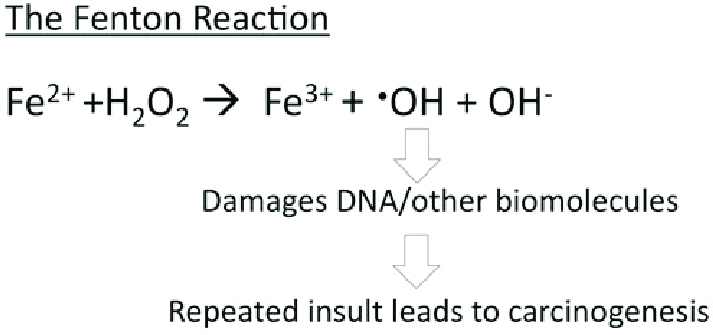User:Alexander Grayzel/Sandbox 1
From Proteopedia
(Difference between revisions)
| Line 28: | Line 28: | ||
[[Image:https://ars.els-cdn.com/content/image/1-s2.0-S0304416510000954-gr1.jpg]] | [[Image:https://ars.els-cdn.com/content/image/1-s2.0-S0304416510000954-gr1.jpg]] | ||
'''Figure 2.''' Ferritin Chelation. The left panel shows a ribbon model of the ferritin subunit, highlighting key helices (A-E) and loop L that form the protein's outer and inner shell. Iron ions (Fe) are visualized within the protein core, with the ferroxidase center located between helices A and B. The right zooms into the ferroxidase center, illustrating the coordination of two iron atoms (Fe_A and Fe_B) by conserved amino acid residues including Glu-27, Glu-62, His-65, <scene name='10/1078819/Single_ferritin_chain_with_iro/2'>Glu-107</scene>, and Gln-141. This center facilitates the oxidation and storage of Fe²⁺ as Fe³⁺ within ferritin.<ref>Bou-Abdallah F. (2010). The iron redox and hydrolysis chemistry of the ferritins. Biochimica et biophysica acta, 1800(8), 719–731. https://doi.org/10.1016/j.bbagen.2010.03.021</ref> | '''Figure 2.''' Ferritin Chelation. The left panel shows a ribbon model of the ferritin subunit, highlighting key helices (A-E) and loop L that form the protein's outer and inner shell. Iron ions (Fe) are visualized within the protein core, with the ferroxidase center located between helices A and B. The right zooms into the ferroxidase center, illustrating the coordination of two iron atoms (Fe_A and Fe_B) by conserved amino acid residues including Glu-27, Glu-62, His-65, <scene name='10/1078819/Single_ferritin_chain_with_iro/2'>Glu-107</scene>, and Gln-141. This center facilitates the oxidation and storage of Fe²⁺ as Fe³⁺ within ferritin.<ref>Bou-Abdallah F. (2010). The iron redox and hydrolysis chemistry of the ferritins. Biochimica et biophysica acta, 1800(8), 719–731. https://doi.org/10.1016/j.bbagen.2010.03.021</ref> | ||
| + | |||
| + | Ferritin converts Fe²⁺ to Fe³⁺ inside the protein core at the ferroxidase site. This ferroxidase site gives ferritin the ability to partially be an enzyme. Fe²⁺ ions enter the ferritin protein core through channels at the 3-fold channel, as explained before. Once inside, the Fe²⁺ ions are brought to the di-iron catalytic site where they are oxidized by either dioxygen (O2) or hydrogen peroxide (H2O2).<ref name="Tosha">Tosha, T., Hasan, M. R., & Theil, E. C. (2008). The ferritin Fe2 site at the diiron catalytic center controls the reaction with O2 in the rapid mineralization pathway. Proceedings of the National Academy of Sciences of the United States of America, 105(47), 18182–18187. https://doi.org/10.1073/pnas.0805083105</ref> This oxidation process produces Fe(III)2-O products, which are precursors to the iron-rich mineral core within the ferritin. By consuming dioxygen or hydrogen peroxide, ferritin minimizes the production of harmful hydroxyl radicals that could arise from the Fenton reaction. Ultimately, the Fe(III)2-O products then from the Fe2O3H2O mineral core, where the Fe³⁺ is stored safely.<ref name="Tosha" /> | ||
=== Iron Delivery and Release === | === Iron Delivery and Release === | ||
Revision as of 23:58, 30 April 2025
Ferritin
| |||||||||||
References
- ↑ Carmona, F., Palacios, Ò., Gálvez, N., Cuesta, R., Atrian, S., Capdevila, M., & Domínguez-Vera, J. M. (n.d.). Ferritin iron uptake and release in the presence of metals and metalloproteins: Chemical implications in the brain.
- ↑ Knovich, M. A.; Storey, J. A.; Coffman, L. G.; Torti, S. V. Ferritin for the Clinician. Blood Rev 2009, 23 (3), 95–104.
- ↑ Bradley, J. M.; Le Brun, N. E.; Moore, G. R. Ferritins: Furnishing Proteins with Iron. JBIC Journal of Biological Inorganic Chemistry 2016, 21 (1), 13–28.
- ↑ 4.0 4.1 Srivastava, A.K., Reutovich, A.A., Hunter, N.J. et al. Ferritin microheterogeneity, subunit composition, functional, and physiological implications. Sci Rep 13, 19862 (2023). https://doi.org/10.1038/s41598-023-46880-9
- ↑ 5.0 5.1 Levi, S., & Rovida, E. (2015). Neuroferritinopathy: From ferritin structure modification to pathogenetic mechanism. Neurobiology of disease, 81, 134–143. https://doi.org/10.1016/j.nbd.2015.02.007
- ↑ 6.0 6.1 Bystrom, L. M., Guzman, M. L., & Rivella, S. (2014). Iron and reactive oxygen species: friends or foes of cancer cells?. Antioxidants & redox signaling, 20(12), 1917–1924. https://doi.org/10.1089/ars.2012.5014
- ↑ 7.0 7.1 Lopachin, R. M., Gavin, T., Decaprio, A., & Barber, D. S. (2012). Application of the Hard and Soft, Acids and Bases (HSAB) theory to toxicant--target interactions. Chemical research in toxicology, 25(2), 239–251. https://doi.org/10.1021/tx2003257
- ↑ Takahashi, T., & Kuyucak, S. (2003). Functional properties of threefold and fourfold channels in ferritin deduced from electrostatic calculations. Biophysical journal, 84(4), 2256–2263. https://doi.org/10.1016/S0006-3495(03)75031-0
- ↑ 9.0 9.1 https://chem.libretexts.org/Courses/Duke_University/Textbook%3A_Modern_Applications_of_Chemistry_(Cox)/10%3A_Bioinorganic_Chemistry/10.04%3A_Iron_Storage-_Ferritin
- ↑ Bou-Abdallah F. (2010). The iron redox and hydrolysis chemistry of the ferritins. Biochimica et biophysica acta, 1800(8), 719–731. https://doi.org/10.1016/j.bbagen.2010.03.021
- ↑ 11.0 11.1 Tosha, T., Hasan, M. R., & Theil, E. C. (2008). The ferritin Fe2 site at the diiron catalytic center controls the reaction with O2 in the rapid mineralization pathway. Proceedings of the National Academy of Sciences of the United States of America, 105(47), 18182–18187. https://doi.org/10.1073/pnas.0805083105
- ↑ 12.0 12.1 12.2 12.3 https://www.thebloodproject.com/cases-archive/the-abcs-of-ferritin/how-does-iron-get-into-and-out-of-ferritin/#:~:text=Iron%20enters%20ferritin%20through%20pores,lysosomes%20%E2%80%93%20a%20process%20called%20ferritinophagy
- ↑ Wang, J., Wu, N., Peng, M. et al. Ferritinophagy: research advance and clinical significance in cancers. Cell Death Discov. 9, 463 (2023). https://doi.org/10.1038/s41420-023-01753-y
- ↑ Boss, M. A., & Chris Hammel, P. (2012). The role of diffusion in ferritin-induced relaxation enhancement of protons. Journal of magnetic resonance (San Diego, Calif. : 1997), 217, 36–40. https://doi.org/10.1016/j.jmr.2012.02.005
- ↑ Kotla, N. K., Dutta, P., Parimi, S., & Das, N. K. (2022). The Role of Ferritin in Health and Disease: Recent Advances and Understandings. Metabolites, 12(7), 609. https://doi.org/10.3390/metabo12070609
- ↑ Liu, J. L., Fan, Y. G., Yang, Z. S., Wang, Z. Y., & Guo, C. (2018). Iron and Alzheimer's Disease: From Pathogenesis to Therapeutic Implications. Frontiers in neuroscience, 12, 632. https://doi.org/10.3389/fnins.2018.00632

